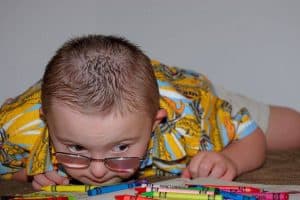Personal stories of children with autism who completed vision therapy for underlying vision problems.
*Names have been changed for privacy protection.
Click here for a list of more success stories pages, you might just recognize your child in.
Kyle, age 11
My son, Kyle, had ‘throwing and catching a ball’ on his IEP for about 6 years, because we knew improving coordination and reciprocal play was important. After all that time, he still was not able to catch even a beach ball. It simply bounced off his stomach and then he moved his arms, sometimes, but too late.
A vision examination two years ago revealed that Kyle had, among other things, significant convergence problems and could not focus on a fast moving object. His eyes were working independently, rather than together , so that he saw two pictures instead of one.
In other words, he never accurately saw the ball as it moved, he only saw it after it stopped. Once the ball was still, he willingly retrieved it and brought it to you.
We began doing the prescribed eye exercises at home for about 10 minutes a day; it seemed more like play than work. After three weeks, Kyle was catching tennis balls!
In addition to enabling Kyle to see moving objects, vision therapy has improved his reading efficiency and comfort, increased his depth perception and improved horizontal and vertical eye tracking, imperative for math and reading music). These exercises also decreased Kyle’s overuse of peripheral vision, reduced his gaze (and task) avoidance, and decreased eye poking and other physical signs of visual strain.
Kyle also wears glasses with prisms lenses to slightly tilt his visual field upward, which helps him to look forward rather than down.
Audrey A., Kyle’s parent
Jimmy, age 12
Our family began vision therapy when it was recommended to us by our son’s speech therapist and audiologist, along with other therapies. At that time our son was receiving many other therapies to help him deal with autism, including allergy medications, music therapy, auditory training (three times), speech therapy, sensory integration therapy, craniosacral therapy, and the medications Naltrexone, Trilafon, vitamin C, and a multivitamin.
We were nervous to add a new therapy that we did not understand, but followed the advice of a valued and trusted therapist. Our first visit was an eye-opener. We did not believe that our 12 year old son would tolerate wearing the glasses because he is very touch sensitive.
As soon as his eye exam was over and the doctor told Jimmy to pick himself out a pair of glasses, he did it! He tried glasses on and even looked in the mirror to see how he looked in them!
Jimmy wore his glasses with no problem. On the way home we stopped at the park to walk on a trail. This was always a gambit because Jimmy had a strong fear of all animals, and if someone was walking their dog Jimmy would jump up on our backs to safety until the dog was gone out of sight. On this day a very large and mean looking dog passed us on the trail and Jimmy was not afraid. He simply looked at the dog as if, “Huh! So that is what a dog looks like. No big deal.” He had only had his glasses for thirty minutes and already our lives were changed.
Before vision therapy he spent long periods of time staring trance-like into space, even as he walked. After vision therapy, Jimmy began to visually investigate his immediate environment. He is now investigating his therapists’ offices as though seeing them for the first time. He plays with his toys more appropriately instead of tapping them or making rows of them.
At age 13, Jimmy can now tie his own shoes. He is able to do this now because he has learned to “look” at what he is doing. He always puts his clothes on by himself, front-ways, and is very proud of this accomplishment. Before, dressing was hit-or-miss, with clothes put on backwards, or shoes on the wrong feet. Jimmy cares about his appearance now.
All of his other therapies have benefited from vision therapy as well. His progress in speech therapy has skyrocketed! He was basically non-verbal a year ago, and now uses speech to communicate. He makes eye contact while communicating with no trouble — before now, eye contact was fleeting.
School is as different as night from day since vision therapy began. Jimmy has a longer attention span, follows instructions better, listens more closely and can sit for longer periods of time. Socially, he is much happier. He wants to be in our company at home, instead of shut in his bedroom. He used to cry when told we were going out, but Jimmy loves outings in the community now, asking to go places every day.
Our life together has definitely changed! Our son is still autistic, and in need of years more of his therapies, but he now makes steady progress and is happy and proud of himself. He likes himself and wants to be an active part of his family, community and world.
Mrs. Roxane B., Jimmy’s parent
Schedule an appointment with a vision therapy eye doctor so that your child can be apart of these success stories.
SEE RELATED: Outsmarting Autism
Susan, age 8
The Vision Therapy Susan receives has not only been helpful in her vision, but also helps her stay focused in activities for a longer period of time. Her speech therapist reports that she can start a task and stay completely focused for as long as 12 minutes. Since beginning Vision Therapy, she has been able to remain in control (with reminders to stay focused) and sit on her own with others for as long as 30 minutes, this is something she could not do 7 months ago. The structure that the therapy provides is apparent in her increased ability to complete a task such as reading 1-2 pages aloud, and also her ability to stay in control in unfamiliar environments.
Thank you very much for all your work and patience, it has been beneficial. Hopefully, the therapy will continue to assist in the goal of independence in most or all areas of her life. Thank you.
Chris V, Teacher
Evelyn, age 6
When Evelyn was 5 years old, we came to Dr. X, who diagnosed that Evelyn had poor vision skills. Evelyn was poor at judging where she and things around her were in space. She was always bumping into door frames, people, etc. and was afraid to ride on her bike. After 9 months of working with Dr. X, Evelyn is now a year ahead of her chronological age in vision skills! She takes in her environment efficiently and moves much more confidently through space.
Mom of Evelyn
Comments from Optometrists
Dr. Randy Schulman
Developmental optometrist Randy Schulman has reported seeing marked improvements in autistic individuals treated with both traditional prescription glasses and special lenses and prisms that alter sensory input. Schulman reported that “of the cases in which I had the opportunity to do vision therapy, …25% [of patients] made slow progress, 30% made fair progress, and 45% made good progress.” Schulman notes that farsightedness, intermittent strabismus (misalignment of the eyes), and other vision problems are frequently encountered in autistic individuals. Schulman suggests that autistic symptoms such as poor visual pursuit and fixation may be linked to cerebellar defects reported by autism researchers.
Schulman cites Donna Williams, a well-known author with autism, who benefited dramatically from wearing color tinted lenses. Williams stated that when she put on her glasses for the first time, “the room didn’t seem so crowded, overwhelming or bombarding. The background noise I had always heard before was not even apparent.” Schulman speculates that for autistic individuals, special lenses and prisms “may break the dependence on an inflexible structure based on misperceptions.”
‘Optometry’s role in the treatment of autism,’ Randy L. Schulman, Journal of Optometric Vision Development, Vol. 25, Winter 1994
Dr. Melvin Kaplan
The poor eye contact, toe walking, and odd neck and body postures of many autistic individuals may be due to vision problems, according to a study that suggests that these abnormal symptoms can be reduced by corrective lenses.
Melvin Kaplan et al. suggests that autistic children have abnormal “ambient vision,” the type of vision used to orient oneself to the environment, movement, and depth. The symptoms demonstrated by autistic children,” the researchers say, “may be an adaptation to an ambient visual system that has distorted the appearance of the spatial environment.”
Kaplan et al. studied 14 autistic children between the ages of 4 and 15, noting their head positions and body posture during activities such as watching television, balancing on a beam, or catching a ball. In addition, the researchers studied the facial expressions of the children. Then they evaluated the children’s head positions, posture, and facial expressions when corrective prism lenses (clear glass lenses slightly thicker at the top or bottom) were introduced. The researchers’ findings:
- Children who previously tilted their heads during activities were significantly more likely to hold their heads erect, in the correct position, while wearing the lenses.
- In the ball-catching task, the prism glasses led to an increase in active catches, and a decrease in passive catches and misses. “Performance improvements in the group were immediate,” the researchers report, saying that “head tilt, posture, and interaction with a moving object were improved.”
- The children’s facial expressions were generally much less tense while they were wearing the corrective lenses.
Kaplan et al. conclude that professionals should consider incorporating corrective ambient lenses into standard treatment programs for autism. The higher level of performance seen in autistic individuals wearing the glasses, they say, “may lead to improved interaction with others at school and play, and perhaps a more pleasurable interaction with the environment.”
Reprinted from Autism Research Review International, Biomedical Update, Page 4, Volume 10, Number 4, 1996, Based on the following study: Postural orientation modifications In autism. In response to ambient lenses, Melvin Kaplan, Dennis P. Carmody, and Alexa Gaydos, Child Psychiatry and Human Development Vol. 27, No. 2, Winter 1996, pp. 81-91.
Can you relate to any of these stories?
If your child is presenting with any signs of a vision problem, schedule a vision evaluation as soon as possible.
LEARN MORE: Vision for Special Needs
The earlier your child is diagnosed with a vision problem, the sooner they can begin a vision therapy program and achieve the skills that will help them reach their potential.

